|
Trooper PFC Ken Hesler
Ken
Hesler, 463rd PFAB, “D” Battery Interview
|
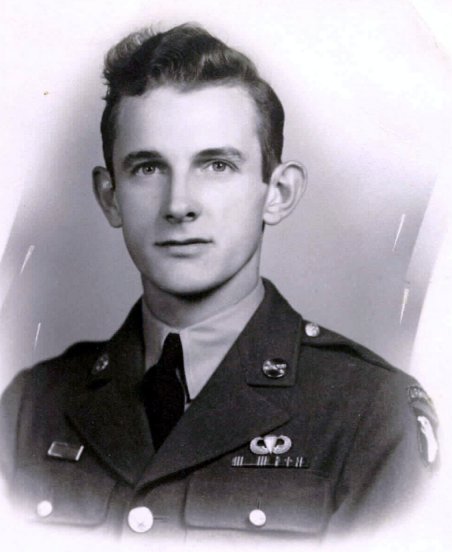
Photo taken following return to
the States in May 1945
|
I was born September 17, 1924, about two miles
north of Greenup, IL, on a small farm, roughly 200 miles south
of Chicago, attending a rural school through the fifth grade.
The year after my father died in 1934, we moved into town and
enrolled in the community schools, graduating from high school
in May 1942, five months following the attack on Pearl Harbor.
Schoolboy to Soldier
I learned about the Japanese attack by radio the day it occurred
and, a few days later, listened as President Roosevelt asked
Congress to declare war on Germany and Italy. The only
course of action for a young man at that time, of course, was to
join the military. I was only 17, but determined to
enlist. The first challenge was to convince my mother to
sign an affidavit that I was really 18. She finally did
when I argued that military service was inevitable and that
enlistees could select a branch of service. She signed,
and I took the oath in the U. S. Army on June 6, 1942, at
Chicago, IL. All my military records indicate that I was
born in 1923, not 1924.
As promised, I asked for the Coast Artillery and got it,
departing soon by train from Camp Grant near Chicago for Fort
Totten, New York, and the 62nd Coast Artillery Battalion
(Antiaircraft) – later Battery E, 893rd AAA-AW Battalion.
My basic training site was in downtown Manhattan, a fenced-in
parking lot alongside the East River with rows of pyramidal
tents. At first, we drilled with M1903 bolt-action
Springfield rifles, World War I style dishpan helmets, and
practiced gunnery on chalk-outlines of pretend 37mm antiaircraft
weapons. After a few weeks, we received M1 helmets and M1
Garand rifles. When Basic ended, I briefly stood
shifts on a 50 cal machine gun post atop a 17-story office
building at the Brooklyn Navy Yard. Not long thereafter,
we were told that we were going overseas. The 37mm guns were
replaced with rapid-fire 40mm Bofor antiaircraft weapons.
Soon we were off to Camp Kilmer, NJ, preparing to embark.
|
|
Heading Overseas
| On August 6, two months after my enlistment, we sailed from Pier
16 at Staten Island for Halifax, Nova Scotia, and thence to
Glasgow, Scotland, making that voyage in the converted Matson
liner SS Monterey. Ironically, that was the same ship on which
the 456th PFAB (from which the 463rd was organized) would cross
the Atlantic to North Africa less than a year later with the
82nd Airborne Division.
We moved by train and truck to England’s Salisbury plain, a
major military training area, about 50 or so miles from London,
to prepare, although we did not then know it, for the November
invasion of North Africa, digging foxholes in the hard chalk,
taking long marches, and again doing duty on a 50 cal machine
gun atop one of the towers of Longford Castle near Salisbury.
Finally, we traveled to the coast of windy Cornwall for practice
with the 40mm, where I trained as a gunner and electronic
tracking operator.
We shipped from Glasgow in late October 1942, aboard the SS
Argentina, going ashore at Mers el Kebir, near Oran, Algeria, in
early November. After an eight-month campaign during
which I was promoted to PFC, we boarded LST 309 at Bizerte,
Tunisia, for a rough ride to Licata, Sicily, and the invasion of
that island in July 1943. |
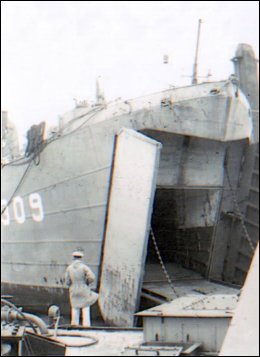
The LST 309 |
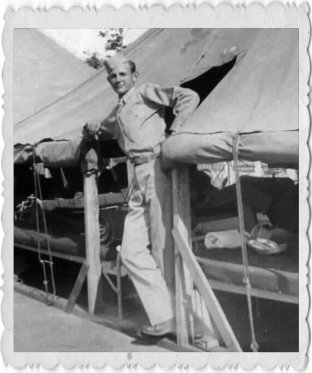
Basic training in Manhattan,
NY parking lot, July 1942
|
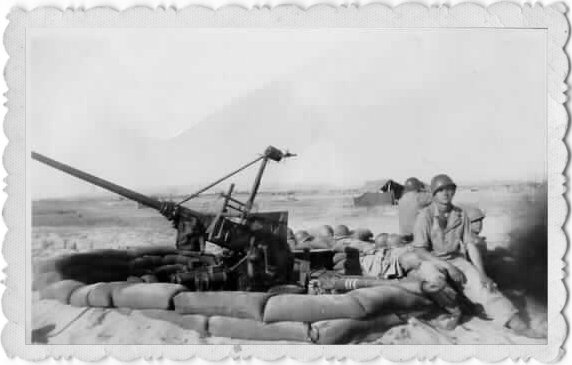
On duty at 40mm Bofors antiaircraft
site near Bizerte, Tunisia,
prior to invasion of
Sicily in July 1943
with 893rd AAA-AW
Battalion. |
Settling Down in Palermo, Sicily
In Sicily, we followed General George Patton northward to
Palermo, arriving in that city the day after it fell. And there
we sat with an occasional German air raid until the spring of
1944 -- one six-hour pass a week and an infrequent opportunity
to visit the U.S. Army hospital in Palermo to donate blood for
$10 a crack and a shot of Red Label whiskey. Under Gen.
Patton in Sicily, a soldier caught not wearing leggings could be
fined $25, along with his commanding officer. The 62nd was a
competent organization, mostly with middle age pre-war officers,
composed of eight guns (crew of 15 men per gun) with guard
shifts 24/7 -- four hours on and eight hours off. To put
it frankly, the war had become boring.
The Airborne Comes Calling
In early spring 1944, recruiters visited the unit to interview
soldiers with combat experience and high school math backgrounds
for possible airborne training. If my memory is correct,
about 20 of us accepted the opportunity. Three of us
survived the four-week jump training and were assigned almost
immediately to the 463rd. My destination was the
Communication Section of “D” Battery.
Sgt. Charlie Keller of York, PA, was the section sergeant.
Among those in that group that I recall were George Blair,
Chattanooga, TN; Louis Probst, Long Island, NY; Ernie Porter,
Falmouth, ME; Joe Boudreau, Plainville, CT; and Tom Mullen,
Brooklyn, N.Y. As a lineman, I went to war armed with wire
cutting pliers, a pocket knife, a roll of tape, and an EE-8
portable telephone, often running in and out of ditches behind a
3/4-ton truck dispensing wire along the side of a roadway.
On occasion, I operated a 12-line switchboard or, more often,
set off along a stretch of wire looking for a line break,
stopping from time to time to make an alligator clip connection
with the other end and then, when successful, back tracking to
find the break and make the repair. In the Maritime Alps, “D”
Battery became a 75mm firing battery. I graduated a bit,
back-packing a radio on an A-Frame with forward observation
parties up winding mountain hillsides, sometimes scrambling
beyond where mules could not go.
The Great Battle of Jausiers
On the night of October 15, 1944, the 463rd fired more rounds
than in any other mission during World War II, as I learned
after the war, in what we came to call the “Great Battle of
Jausiers. Col. John Cooper, Battalion Commander, later
reported that mission this way -- “Halfway through the month of
October, the Germans launched a late evening attack aimed at
securing two strategic peaks. By firing five thousand six
hundred (5,600) rounds of direct fire on the peaks, the attack
was repulsed and the enemy driven back.”
| Although I was not a member of a gun crew, all available hands
were drafted to carry ammunition from a steady stream of
arriving 2 ½-ton trucks. As the firing continued, a light
rain began, and the narrow trails from the roadway up to the “D”
Battery guns grew slippery. It became difficult to avoid
falling on trip after trip while carrying the 30lb crates of
ammunition. It was one of the most frustrating challenges of
the campaign.
French Riviera to Frozen Bastogne
As winter approached in late October, we left Jausiers for the
Menton area to support the First Special Service Force, being
relieved in mid-November for a brief bivouac in Gattiers near
Nice before heading north to Mourmelon and the 101st for a few
days of indoor living and warm showers.
My trip from Mourmelon to Bastogne was in the rear of a
tarp-covered 2-1/2-ton truck manned by a Red Ball Express driver
and loaded with five-gallon cans of gasoline with seven or eight
of us scattered about on the wood benches. It was a night of
fitful sleep with my legs stretched across the gasoline cans.
The trip seemed to last forever, particularly as our part of the
convoy took a wrong turn and had to do an about face. Upon
arriving in the Bastogne area near Flamizoulle, we assembled
along the road among a plot of young trees and dug foxholes,
positions we assumed until we moved on later in the day to
Hemroulle.
With the 101st surrounded at Bastogne and “D” Battery set up to
fire in a 360-degree circle, the demand for forward observation
teams was ongoing. As a result, the Communication Section
maintained a more or less regular schedule of three FO days out
and three days back in the Battery area. As a result, I
spent considerable time at Bastogne on FO duty as a
telephone/radio operator, mostly the former.
|
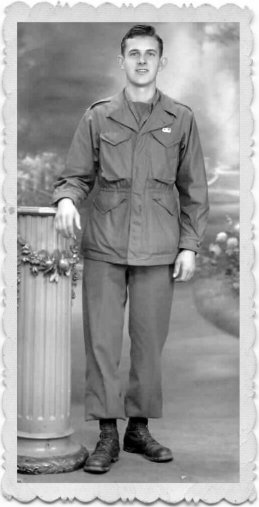
Nice, France, 1944. |
Hemroulle
Among my various Battery area duties were (1) foraging to find a
stove and fuel for the warming tent, along with carpeting
material for the floor and door flap of my rarely-used log
foxhole dug into the side of a wooded ridge, (2) venturing out
into the surrounding area during the early foggy days as one of
several two-man bazooka teams in search of enemy intruders but
encountering none, (3) digging a bazooka hole on the south side
of the Bastogne-Hemroulle road that we manned regularly,
and (4) huffing and puffing while running in an overcoat
through foot-deep snow to repair breaks in telephone lines.
I was in the battery area and took part in recovering supplies
during the first relief parachute drop on December 23. On
Christmas Eve, I attended services in the barn near the
Battalion CP in Hemroulle, and then did sentry duty along the
Hemroulle road during shifts from 8-10 p.m. and 2-4 a.m.
During the early shift, I witnessed the bombing attack on
Bastogne with its accompanying display of aerial flares and, in
the early morning, heard the bombs falling near Champs.
It was eerily quiet and cold when I curled up after 4 a.m. in my
sleeping bag at the warming tent alongside the
Bastogne-Hemroulle road, removing only my overcoat and shoe-pacs
to dry the felt insoles. Sometime later, I was
startled as all hell broke loose in the area. Hastily
donning boots and overcoat, I grabbed my carbine and ran, with
others, to a ridge alongside the road, assuming a defensive
position facing the firing sounds, but we could see nothing.
My other memory of that Christmas Day was a meal of two hot
pancakes sprinkled with sugar.
It was also from the bazooka hole on another day that two of us
watched as one of our 50 cal. machine gunners atop a small hill
north of the road let go a burst at two planes overhead that
just happened to be friendly. They reacted by circling
back and dropping two bombs that could be seen clearly arcing
toward the ground. No one was hurt. Hasty
shouts for the display of recognition panels accompanied the
event.
FO Expeditions, Here and There
Observation parties always began in roughly the same way.
Whether rainy, foggy, or freezing cold, I would find myself in a
jeep with musette bag and bedroll riding through the countryside
with no idea of where we were going. I do not remember the
lead observers, other than Lt. Jack West and Sgt. Keller.
With limited exceptions, these trips were about the same.
Our jeep would pull off the roadway, into an area of scrub brush
where a few other vehicles were already parked and walk into the
edge of a dark pine woods with a wet carpet of needles or snow
underfoot. Eventually, we would come upon a small group of
infantry inside the outer edge line of the woods, beyond which,
a few hundred away, the enemy kept within the cover of another
forest. I do not recall needing to lay any wire on these
missions as the first task was always to find our tagged wire
wrapped around a tree trunk, attach the telephone, and make
contact with Fire Direction Center.
Two of us would dig a two-man sleeping foxhole. More often
than not, the first fire mission was to register the guns with
smoke and stand by for visible targets or others relayed by the
infantry. My usual task, was to man the telephone and
repeat the observer’s words back to the Fire Direction Center.
Occasionally, harassing enemy artillery or mortars were fired
into our area; and at night, the chatter of machine guns and the
explosions of artillery could be heard in the distance.
Two memorable events occurred on these missions, both of them in
the days shortly after Christmas.
One of them involved a glider bearing doctors and medical
supplies landing nearby in an open area to the right of our
wooded position. As those on board came dashing into the
woods, small arms fire could be heard among the treetops.
After being told what that noise was, they dashed off hastily to
the rear. It was then that the lieutenant in charge of our
party directed me and two others to “Get out there and unload
that glider.” I was first into the craft and began passing
bundles along to the others who were scurrying back and forth to
the edge of the woods. It is surprising how “strong” one
can be under those circumstances. We were wary that the
Germans could see us and awaited some reaction, but nothing
happened.
The other well-remembered event took place sometime near the end
of December and not long before the Germans departed the Champs
area, when our FO party quartered on the second floor of the
Rolle Chateau. The observation post was atop a nearby ridge with
a good view of the area north of Champs. It was a narrow,
two-man hole with seats dug into opposite sides and just room
for two persons to sit below ground level, with only the radio
antenna protruding.
One cloudy afternoon, Sgt. Keller and I watched as about six
American armored vehicles set out across an open field to our
left, firing one or two rounds into each of a series of
haystacks as they advanced, until the enemy returned fire from
an unseen location, crippling at least two of the vehicles
before the others scuttled away in reverse. Later
that night, Sgt. Keller crawled out of the hole and said he was
off to see what he could find aboard the damaged American tanks,
leaving me alone to wonder how I could identify him on his
return. Teaming up with Sgt. Keller was always an
adventure.
A second event at Rolle Chateau occurred when I was alone in our
bare second-floor quarters, awaiting the delivery of the evening
meal by way of a ¾-ton truck and insulated mermite container.
My task was to “prepare” dinner by heating one of the pans
filled with meat, potatoes, and gravy, a rare delicacy at
Bastogne. The single-burner Coleman stove was warming the
food near a window when two rounds of enemy artillery fire
exploded in the courtyard not far from the window. Glass
shards fell all around the stove and, as far as I could tell,
into the food container.
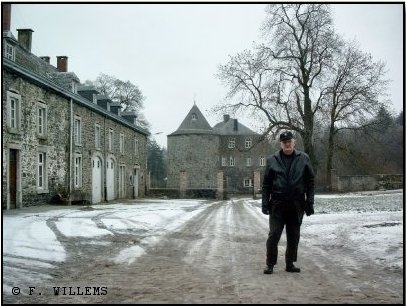
Ken at the Chateau Rolle in 2004,
at left are the FO second-floor quarters.
Faced with the immediate quandary of how to deal with this
“precious” food before the others returned, I found a quick and
simple answer. Taking an undershirt from my musette
bag, I dumped the container of food into my metal helmet and,
using the shirt, carefully wiped clean the pan and each piece of
meat and potato to insure the absence of glass. To finish
the task, I strained the gravy back into the pan through the
shirt and began reheating the meal. I do not recall how I
disposed of the shirt, but all unknowingly enjoyed the fare.
Hello Paris
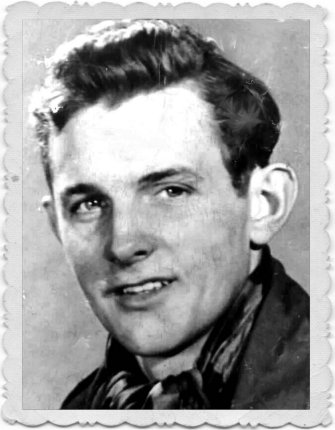 |
On January 11, a Thursday, I learned that I was among those to
receive a 48-hour pass to Paris over the coming weekend, leaving
the 12th and returning the 15th. Under an open tarpaulin
shelter on that same day and in the freezing weather, I took my
first bath in several weeks, unclothed, and with one foot after
the other in a bucket of warm water. The following day, we
rode in a convoy of a jeep and two open 2 ½-ton trucks for
nearly four hours, sitting huddled inside our sleeping bags.
Our destination was the Rainbow Corner Red Cross club located in
the Hotel de Paris on the boulevard de la Madeleine.
Bill Kummerer and I, both of “D” Battery, shared a room on the
second floor. On the second night we rode the Metro to
Place Pigalle and spent the night accepting champagne from a
group of Air Force officers at Club Eve, somehow making it back
to the hotel in the early morning walking through the cold
streets and alleys of Paris. The following day, we
returned to the Battalion to find that it had left Hemroulle and
taken up a position near Recogne.
Picture at left :
#4-Forty-eight-hour leave to Paris
January 12-15, 1945 at Red Cross’ Rainbow Center, Hotel
Paris. Pass noted “No blouse issued,” so field jacket
and camouflage chute scarf were fine. |
Moving Indoors
It was not too many days later that the Battalion, mostly in
covered ten-ton trucks with straw on the floor, moved south with
the Division over slippery roads to Keffendorf in the Alsace
region and, several days later, on to Wintershouse near the
Moder River. It was there that I was assigned to Fire
Direction Center, sitting around a table in a local school house
working the telephone for “D” Battery under the direction of
Maj. Vic Garrett, Battalion S-3. My quarters were nearby
on the second floor of a half-timbered house where I resided
until we returned by train to Tent City at Mourmelon.
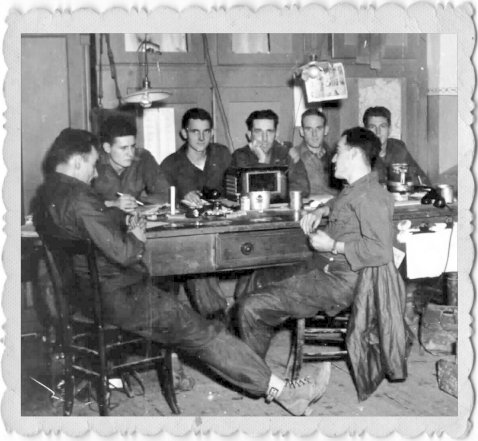
Ken Hesler : "A scene in the
Fire Direction Center in Alsace (Winterhouse).
In the photo, I am
the third from the left.
I knew the others in the photo a relatively short time and do not
recall their names
although they all look familiar.
They are from the other batteries.
Each of us handled phones to the respective batteries during fire
missions.
Maj. Vic Garrett was in charge of the operation.
You can see we were playing cards during a lull in activity."
A Brief Stay in Tent City and Off for the USA
| A short time after our return to Mourmelon, we rehearsed in full
dress uniform for the Presidential Unit Citation ceremony,
preparing for Gen. Eisenhower’s visit on March 15, but I did not
remain with the 463rd for that grand occasion. Following a
stint of guard duty over general prisoners unloading a freight
train, I reported back to the Battery CP to return my clip of
ammunition where an officer asked if I wanted to “Go home to
Greenup, Illinois.”
Unaware at the time that I had hit the 85-point rotation level
on the Advanced Service Rating Score (ASR) after being overseas
nearly 32 months, I was surprised but readily accepted the
offer. Along with a number of others from the
Division, we left Mourmelon by truck on March 12 for Le Havre,
France, where we loaded aboard the SS Marine Robin for the trip
to the USA on 30-day “temporary duty” leaves. I made it
home April 8, hitch-hiking the last 30 miles with my barracks
bag compliments of a truck driver who rerouted his trip.
When the war ended, my leave was extended to 45 days, after
which I was discharged May 28 at Fort Sheridan north of Chicago.
Life After the 463rd
After one year of college under the G.I. Bill, I decided to make
the Army a career, and re-enlisted for 18 months with the 3rd
Armored Division at Fort Knox, KY, where I was promoted to
Sergeant and assigned as permanent party in Headquarters,
Headquarters Company. While there, I taught in the
Division’s cadre school, the Universal Military Training
Experimental Unit, and assisted in the development of lesson
plans for other training centers until the end of my enlistment
in November 1947. Rather than re-enlist, I returned to college
upon the advice of my commanding officer, receiving a diploma
from Eastern Illinois University in June 1951.
Following graduation, I began a 33-year teaching and
administrative career at the same institution, at first in an
acting position for a person on sabbatical leave. I earned
a Master’s degree from the University of Illinois and later did
advanced study there in Mass Communications and American
Literature. I met my wife at the university. We
will celebrate our 60th anniversary December 22, 2011. We have
one daughter.
|
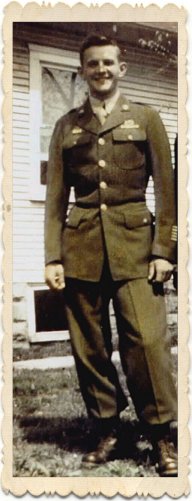
Back home
in spring of 1945 |
In the late 1970s, Joe Lyons, Cecil Farmer, and I, among
others, made an effort to find former unit members for our first
reunion at Nashville, TN, in 1980. In recent years,
several of us have worked with Filip Willems in Belgium to
establish and maintain the 463rd website, relying, in part, on
the more than 2,000 pages of Battalion records I obtained from
the National Archives in 1987 that document the day-by-day
operational history of the Battalion from February 1944 through
October 1945.
I retired as Director of University Relations and Advancement at
Eastern Illinois in December 1984. Since then, I and my family
have traveled on several occasions to the battlefields of
Europe, including serving in 1994 as one of two 101st veterans
escorting U.S. Secretary of State Madeleine Albright at the
Commemoration of the 50th Anniversary of the Battle of the
Bulge. I have been active as a member of the 101st
Airborne Division Association since the middle 1980s in the
areas of finance, membership, and public affairs.
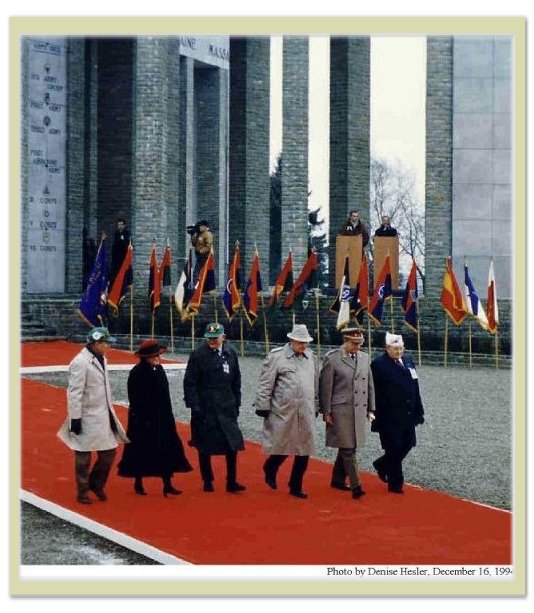
Kelly
Stumpus, left, and Ken Hesler, third from left, both veterans of the 101st
Airborne Division, escort U.S. Secretary of State Madeline Albright, second from
left,
at the 50th commemoration of the Battle of the Bulge wreath laying in
December 1994.
The site is the Mardasson Bulge Monument just outside of
Bastogne, Belgium.
Two other Bulge veterans at right escort King Albert II of
Belgium for the ceremony.
Reflections
Like most soldiers barely beyond their teens, we were imbued
with an inherent belief that we were immortal. That is why
the young are called upon to fight wars. But that saving
grace did nothing to ease the conditions of the soldier in
wartime – insufferable boredom, blistering heat, freezing cold,
soaking rain, homesickness, weariness, hurrying up to wait, and
learning to live with fears from which one cannot flee.
As we grew older, we lost that youthful sense of immortality but
gained the nostalgia of the survivor. Sure, the war was
bad, but we had some great times. We had numerous
once-in-a-lifetime experiences and saw a great deal of the
world. For a depression era kid, the food was pretty darn
good. And those wartime buddies with whom we shared both
danger and laughter became friends for life. Despite all
its hardships and dangers, World War II was the most significant
factor in shaping my life, aside from family. As for service
with the 463rd, although often difficult, it was in retrospect
an experience that I have long treasured. The hallmarks of
the unit were high morale, dedicated soldiers, and first-class
officers.
Prior to the war, I was heading no place. I did janitorial
work at my local school, delivered newspapers, sold muskmelons
from a hand-pulled wagon, collected and sold scrap iron, and
worked as a clerk and apprentice butcher in the local grocery
store. The major job opportunity for adults in the
community was the local shoe factory. My highest salary at
the grocery store for a full six-day week of summer work was
$15. Higher education was not an option or even a thought.
The war forced upon me, in just three years, a level of maturity
and sense of responsibility not otherwise achievable. It
gave me the G.I. Bill, an educational ticket to a new life and a
step up the ladder. Most of all, my war experiences,
particularly with the 463rd, gave me a sense of pride and an
everlasting conviction that I had done something that was
special, that really mattered, and that actually made the world
a better place, however small that contribution may have been.
THANKS
Mr. Hesler, thank you very much for this
interview !
|
|